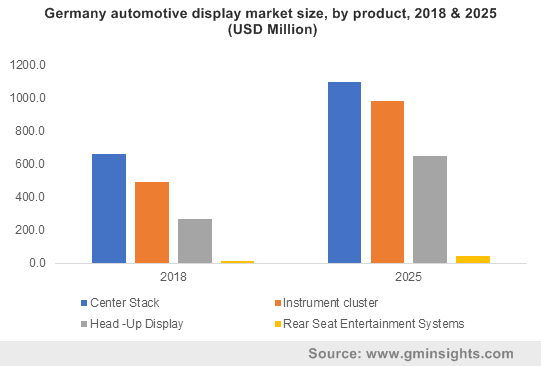Global automotive display market shipments to register a double-digit CAGR over 2019-2025, industry contenders to invest in advanced display technologies
Publisher : Fractovia | Published Date : 2019-04-30Request Sample
That the automotive display market is poised to record commendable growth over the coming years has been evident at the 2019 Consumer Electronics Show (CES) which witnessed the launch of massive display units in passenger cars. For instance, premium electric auto manufacturer Byton showcased its first production-ready cockpit focusing on two massive infotainment displays, one mounted on the steering wheel while the other spanned the entire width of the dashboard.
Germany automotive display market size, by product, 2018 & 2025 (USD Million)

The massive infotainment system powered by Blackberry is 49 inches across and is 9.8 inches tall and has sent ripples of anticipation among automotive display market players as it effectively replaces the conventional dashboard with the screen. The steering wheel mounted display is placed directly in front of the driver and thus is an effective extension of the car's UI control. The occupants of the car can access a shared experience with combination of intuitive voice commands and gesture and touch based actions that can be used to interact with the car.
Fueled by the rise of more connected cars, super-sized displays are proving to be an undeniable trend in the automotive world with the display screen becoming the windows to the digital world. At the 2019 CES, Mercedes EQC crossover featured two 10.25-inch displays that formed a free-standing screen by being placed behind a glass surface. While car manufacturers are designing rear view mirrors to double up as image projectors for a rear-facing camera, heads up displays (HUD), that impart valuable information to the driver by projecting images that float on the windshield, are taking the automotive display market by storm.
Ranging from the Mazda3 to the BMW 7 Series, most of the latest car designs are being equipped with advanced HUDs that are a fusion of tech and safety feature. Moreover, car owners do not have to necessarily trade in their old cars to add HUDs to their vehicles as the aftermarket sales for such devices has registered a strong growth trend as well. The head-up automotive display market is set to explode with analysts being of the opinion that it would surpass an appreciable milestone by 2025.
OEMs like Porsche are seemingly aware of such a trend and are looking to capitalize the same, as is evident from its decision to invest in the Zurich based developer of AR technology and hardware, WayRay. Not only Porsche but other automotive industry giants like Hyundai Motor besides investors in technology like Alibaba have observed the promising future of augmented reality displays being developed by WayRay and therefore have participated in the $80 million Series C funding for the company, which already has a valuation of $500 million.
As the demand for such HUDs become more widespread due to advantages like providing additional information, assistance to drivers and entertainment to passengers, others like Continental and Panasonic are also entering the segment with an array of products on offer adding further stimulus to the automotive display market.
Most of the display panels at present are TFT LCD, however the automotive display market is expected to veer towards OLED panels in the coming years due to the freedom of design and flexibility that thin plastic substrates of OLED panels offer. It is also becoming the display material of choice as it has faster response speed, higher contrast ratio and wide-angle higher visibility when compared to LCD.
For instance, the futuristic design of Audi e-Tron has replaced the outside mirrors with cameras that capture everything that is happening behind the vehicle and display the same on OLED screens on the inside of the car’s doors. These displays are even touch enabled and a fitting feature in a high-end vehicle that comes at a retail price as high as $90,000. Samsung Electronics, one of the major manufacturers of the OLED panel industry, has projected OLED panels for electric field to grow from 100,000 sheets in 2019 to 3 million sheets in 2022. The automotive display market will definitely play a significant role in such a massive growth of application for OLED display panels.
Automotive displays have become the key human machine interface for HVAC controls, audio and media systems, navigation and telematics. Style and elegance of the display unit is valued by consumers just as much as the functionality and features of the unit. As designers come to comprehend the technology trends in automotive displays, it is estimated that the automotive display market will surpass $30 billion by 2025.